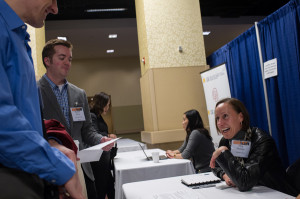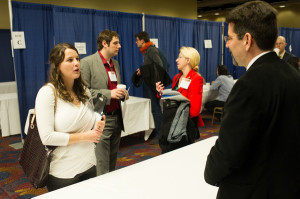This blog post is part of a regular series to inform the AHA Today readership and AHA membership about Career Diversity for Historians, the AHA’s initiative to broaden the career horizons of history PhDs. For more information, check out the Career Diversity for Historians web page, and follow #AHACareerDiversity on Twitter.

Meg Phillips of the National Archives and Records Administration converses with early-career historians at the AHA’s Career Fair at the 2015 annual meeting.
Those of us with a passing acquaintance with the 1990s will remember The X-Files insisting that “the truth is out there.” As researchers, though, we know that that sometimes the hardest part of finding an answer is knowing where to look. As Career Diversity for Historians has evolved, one information gap in particular has emerged: between knowledge of “The Many Careers of History PhDs” and knowledge of how to learn from those pathways. In part to close this gap, we recently launched AHA Career Contacts, which matches graduate students and early career scholars with history PhDs employed beyond the professoriate for one-time informational interviews.
Interest in this sort of information has been growing for a while, demonstrated most recently at the AHA’s recent annual meeting in New York: the popularity of the Professional Division’s long-running (more than a decade!) interviewing workshop with historians in a variety of careers; the success of the Career Fair, for two years running; and a stream of member-proposed panels that highlight career paths beyond the professoriate. For an excellent review of related sessions, see Jen McPherson’s post on AHA Today.

Rob Townsend of the American Academy of Arts and Sciences speaks with interested job seekers at the Career Fair.
The need for this type of advice is real: too many historians perceive the tenure track as a fixed path with benchmarks that can be anticipated, while assuming that everything else is non-normative, and therefore much more complex and confusing. The hidden complexities and vagaries of the tenure track suggest a topic for another post, but when a full quarter of history PhDs are employed beyond the professoriate, the discipline gains nothing from obfuscating their career paths. As an ABD graduate student who recently signed up as a junior contact put it: “I came to my PhD program knowing that I wanted [a career] where I could still research and write history, but use my research to provide context and meaning for a public audience. I’m looking forward to being able to ask the most basic of questions and getting feedback on how to tailor my CV for the career I’m looking for.”
AHA Career Contacts capitalizes on the success of past ventures, seeks to extend these resources to all historians, and aims to make them available in between annual meetings. The structure is quite simple: aspiring contacts fill out short Google forms, I contact potential matches to get a fuller sense of what they are looking for, and then I match them based on mutual interests and geographic proximity. The outcomes and expectations are likewise simple: all either party is offering is a one-time informational interview—a chance to speak with a historian employed beyond the professoriate and a chance to share, however briefly, the benefit of experience.
In the end, it may be most accurate to say that “the truths are out there,” and Career Diversity for Historians is trying to help find them.
Sign up for AHA Career Contacts, and if you have questions about the program, please contact Emily Swafford.
This post first appeared on AHA Today.
Tags: AHA Today Career Diversity for Historians Resources for Early Career Resources for Graduate Students
Comment
Please read our commenting and letters policy before submitting.






